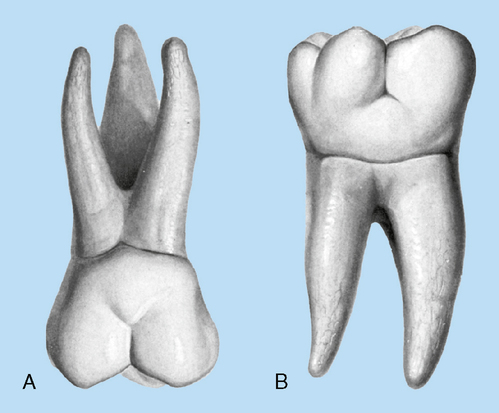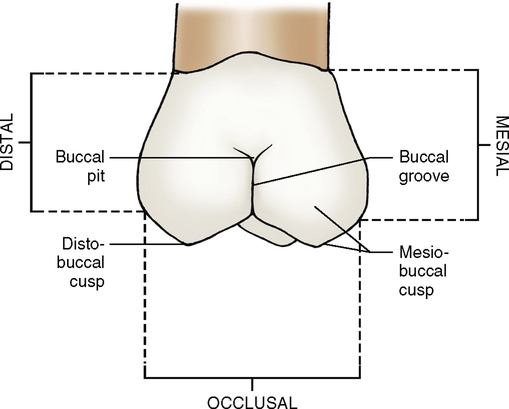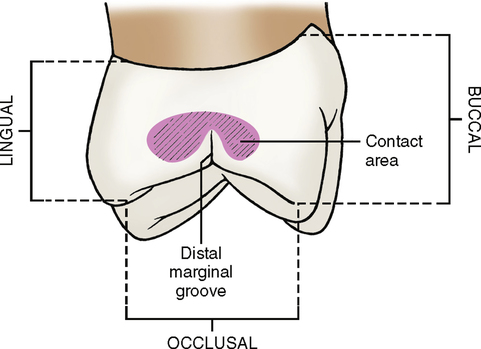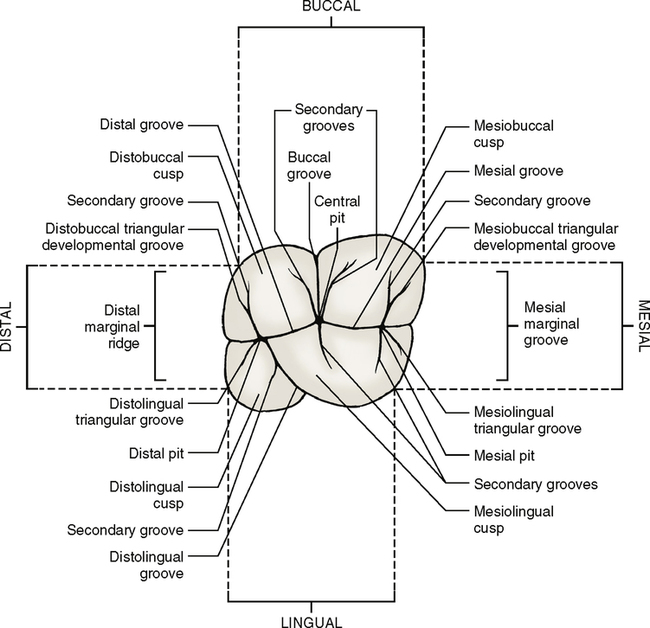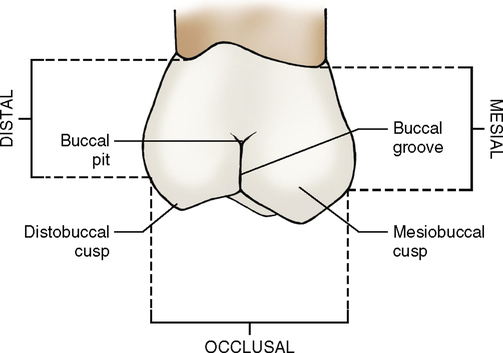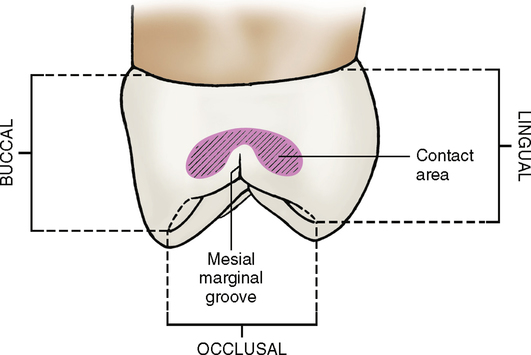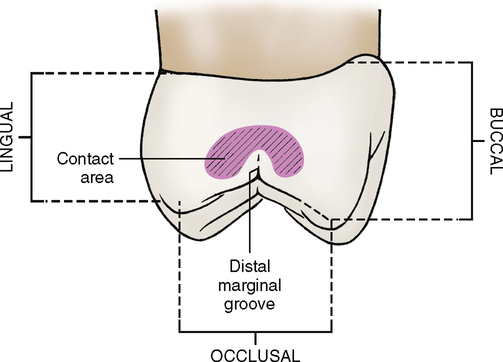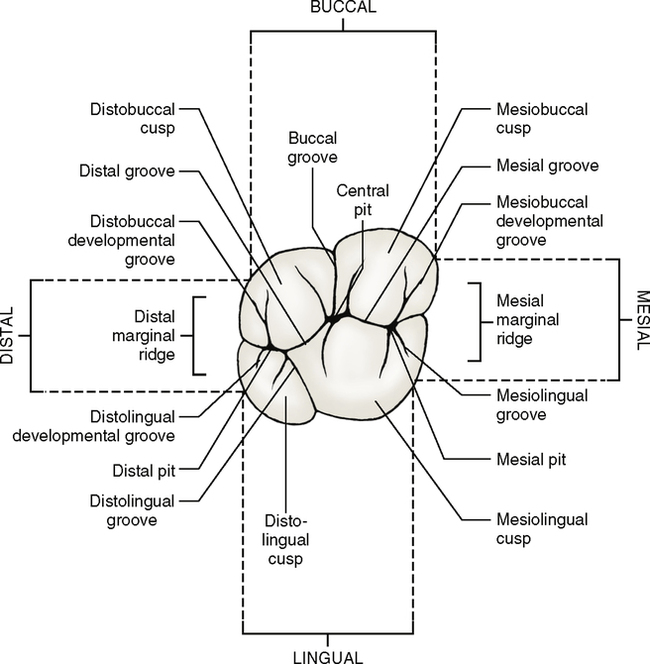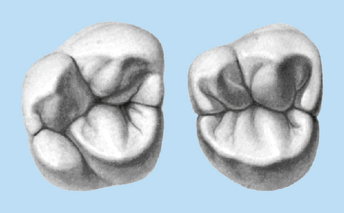Molars
• To understand the lobe formations of the crowns of molars
• To compare the formations of first, second, and third molars
• To understand the anchorage of the roots as a resistance to forces of displacement
• To describe the details of the various molars
• To make comparisons among the various molars: maxillary and mandibular, as well as first, second, and third molars
The 12 permanent molars are the largest and strongest teeth in the mouth by virtue of their crown bulk size and root anchorage in bone (Fig. 15-1). Their primary function is to grind or crush food.
Eruption Times of Molars
| Eruption | Enamel Completion | Root Completion | |
| 1st molar | 6 to 7 years | 4 years | 9 to 10 years |
| 2nd molar | 11 to 13 years | 7 to 8 years | 14 to 16 years |
| 3rd molar | 17 to 22 years | 12 to 16 years | 18 to 25 years |

Generally, the first molars are formed from five lobes, but some second and third molars may have only four lobes. The lobes in Fig. 15-2 are numbered in the order of their size, with number 1 being the largest.
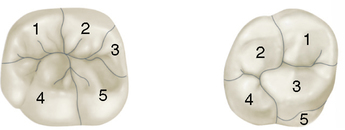
The maxillary molars have only three major cusps, one minor cusp, and sometimes one supplementary cusp. The mandibular molars usually have four major cusps and sometimes one minor cusp (see Figs. 5-5 and 5-6).
MAXILLARY MOLARS
First Molars
Evidence of calcification: Birth
The maxillary first molars (Fig. 15-3) are normally the largest teeth in the maxillary arch. The three molars on each side are the first, second, and third maxillary molars. Each has three well-developed major cusps and one minor cusp, all of which are functional. The fifth or supplemental cusp, which is afunctional, is called the cusp or tubercle of Carabelli. This fifth cusp is usually found on all maxillary first molars.

Facial (buccal) aspect
From the buccal view (Fig. 15-4; see Fig. 15-3, A), four cusps can usually be seen: mesiobuccal, distobuccal, mesiolingual, and distolingual. The two lingual cusps are not located directly behind the buccal cusps but are distal and lingual to them. Although the mesiobuccal cusp is broader than the distobuccal cusp, the latter is usually sharper and longer. The mesiobuccal cusp forms an obtuse angle (more than 90 degrees), where its mesial slope meets its distal slope at the cusp tip. The distobuccal cusp usually forms a less obtuse angle where the mesial slope meets the distal slope.
Lingual aspect
The lingual cusps alone can be seen from the lingual aspect (Fig. 15-5; see Fig. 15-3, B). The mesiolingual cusp is much longer and larger than either of the buccal cusps. Wider mesiodistally and buccolingually, the mesiofacial cusp is the next largest, although it is not as long as the distofacial cusp. The distolingual cusp is the smallest and the shortest of the functional cusps. Of course, the cusp of Carabelli is the shortest and smallest of all five cusps, but it is afunctional. In fact, the cusp of Carabelli is not a cusp at all but rather a tubercle. A fifth-cusp developmental groove, called the mesiolingual groove, separates the cusp of Carabelli from the mesiolingual cusp.
Mesial aspect
The mesial aspect (Fig. 15-6; see Fig. 15-3, D) of a max-illary first molar usually shows a clear profile of the cusp of Carabelli. The lingual crest of curvature is at the center of the middle third of the crown, the buccal crest at the cervical third. The cervical line is slightly convex mesially.
Occlusal aspect
A maxillary first molar has a rhomboidal occlusal outline (Fig. 15-8; see Fig. 15-3, C). The molar crown is wider mesially than distally; it is also wider lingually than buccally. This is the only tooth that is wider lingually than buccally. Is the occlusal outline of a maxillary first molar more like a square or more like a square that has been squashed sideways? What is the difference between a rhomboidal and a square form?
Other anatomic structures
The primary grooves of the maxillary first molars are as follows:
Second Molars
Evidence of calcification: 3 years
Enamel completed: 7 to 8 years
Root completed: 14 to 16 years
A maxillary second molar (Fig. 15-9) supplements a first molar’s function. Generally speaking, the differences that occur between the first and second molars are even more accentuated between the first and third molars. In other words, certain characteristics in form and development occur in a first molar that occur to a lesser degree in a second molar and possibly not at all in a third molar. What are these characteristics? Following is a list of several traits that may occur, but in general they have a tendency to be more accentuated in a second molar and most accentuated in a third molar.
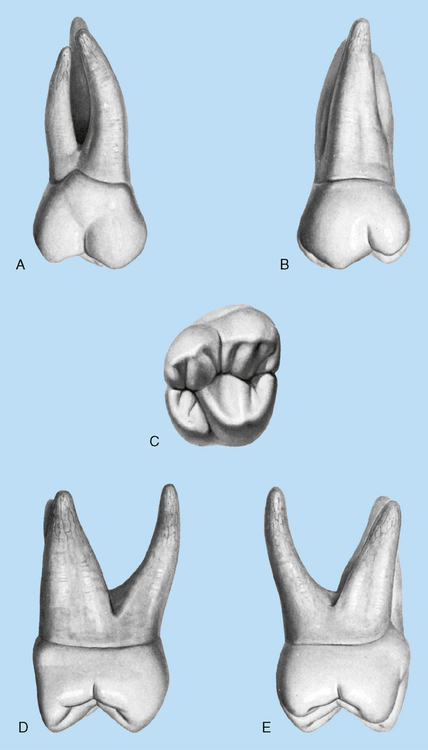
1. The maxillary molar crowns are shorter occlusocervically and narrower mesiodistally in the second molars than in the first molars. The third molars continue to be smaller in all crown proportions, including buccolingually.
2. The molar crowns show more supplemental (secondary) grooves and pits on the second molars than on the first. The third molars show even more supplemental grooves and accidental (tertiary) grooves and pits.
3. The oblique ridge is less prominent on the second molars and in some instances disappears almost entirely on the third molars.
4. The fifth lobe, or cusp of Carabelli, usually disappears on the second molars and occurs infrequently on the third molars.
5. The distolingual cusp is less developed on the maxillary second molars and disappears almost entirely on most maxillary third molars.
6. The occlusal outline of the second molars is less rhomboidal and more heart shaped. A third molar is even more heart shaped in occlusal outline.
7. The roots of the second molars have a tendency to lie closer together and may even be fused.
8. The mesiobuccal roots of the second and third molars have a greater tendency to curve distally in their apical third. The distobuccal root of a maxillary second molar is straighter than that of a maxillary first molar, with little or no mesial curvature. The third molar’s distobuccal root has a tendency to curve distally in its apical third.
9. The roots of the second molars are almost as long and sometimes even longer than those of the first molars. The roots of the third molars are almost always smaller than those of either the first or second molars.
10. The second molars show more variety of form than the first molars, not only in the crown but also in root development. The third molars show unlimited variety in crown and root formations and are often congenitally missing.
Occlusal aspect
The occlusal outline (Fig. 15-14; see Fig. 15-9, C) of the crown of a maxillary second molar is less rhomboidal than that of a maxillary first molar. The increase in size of the mesiolingual cusp and the absence of the cusp of Carabelli makes this possible. Also the distolingual cusp is smaller.
Third Molars
Evidence of calcification: 7 years
Enamel completed: 12 to 16 years
Root completed: 18 to 25 years
The crown of a third molar is shorter than that of a second molar, and the roots tend to fuse into one fused root. The occlusal outline of a maxillary third molar is heart shaped. The distolingual cusp is poorly developed or even absent (Fig. 15-15).
Roots
Maxillary molars are trifurcated and have three roots—mesiobuccal, distobuccal, and lingual—connected to a single root trunk (Figs. 15-16 and 15-17). Trifurcation gives maxillary molars sturdy anchorage against forces that would tend to displace them. The lingual root is the longest, and the distobuccal is the shortest.
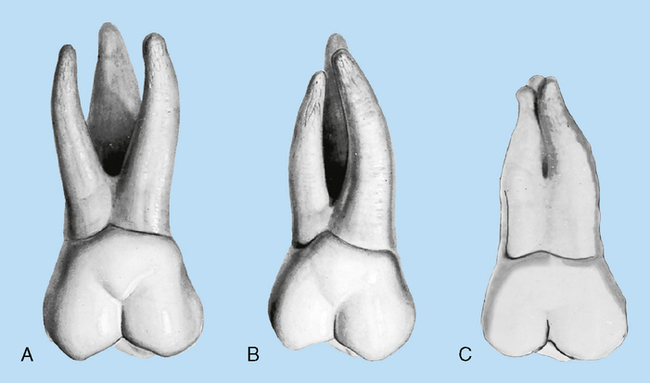
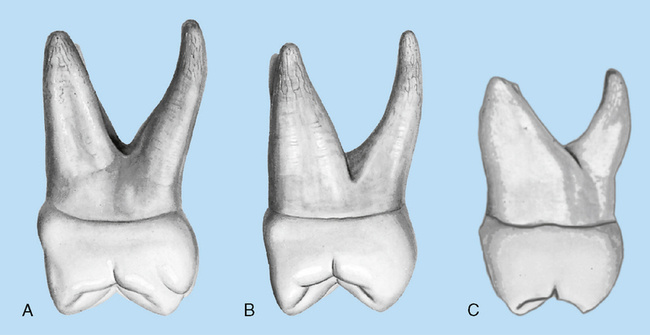
All three roots are usually visible from the buccal view (see Fig. 15-16). The two buccal roots incline distally, with the mesiobuccal root starting to curve at its middle third. The distal root is usually straighter and tends to cur/>
Stay updated, free dental videos. Join our Telegram channel

VIDEdental - Online dental courses


